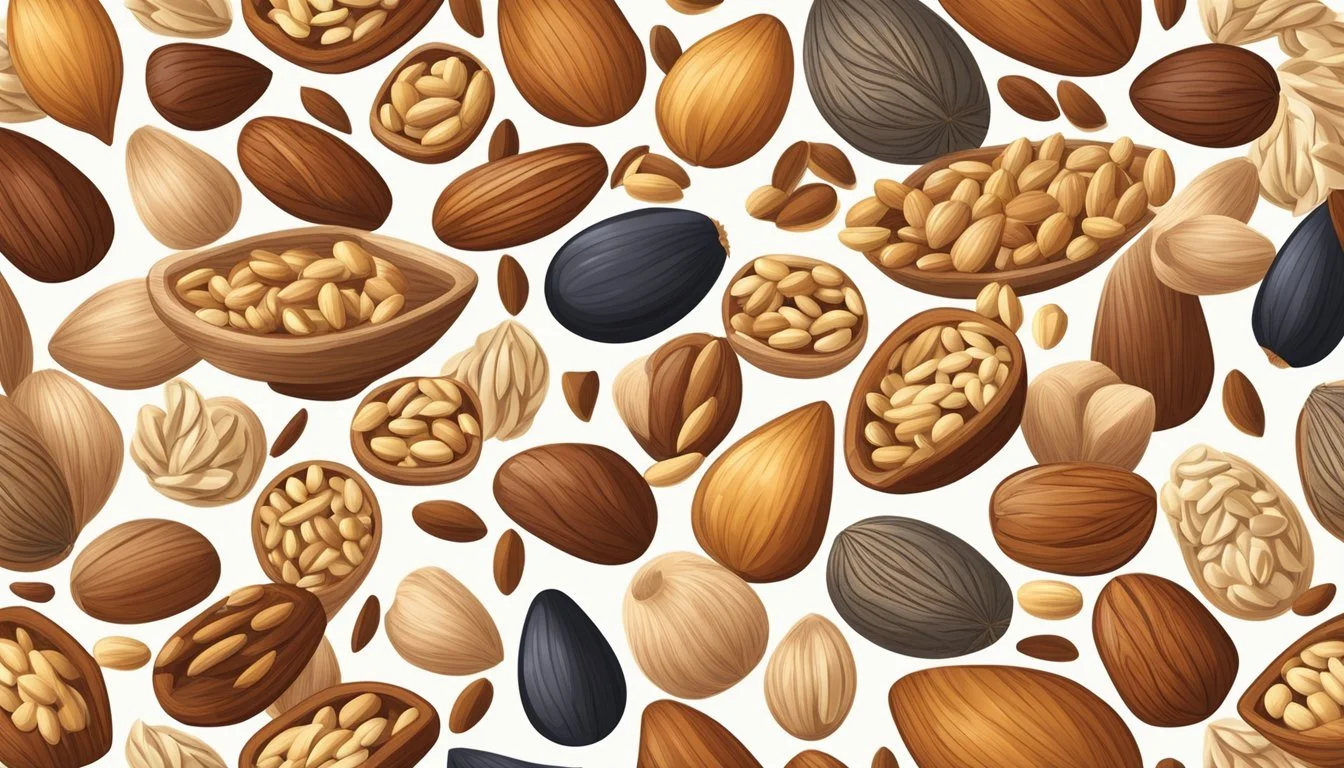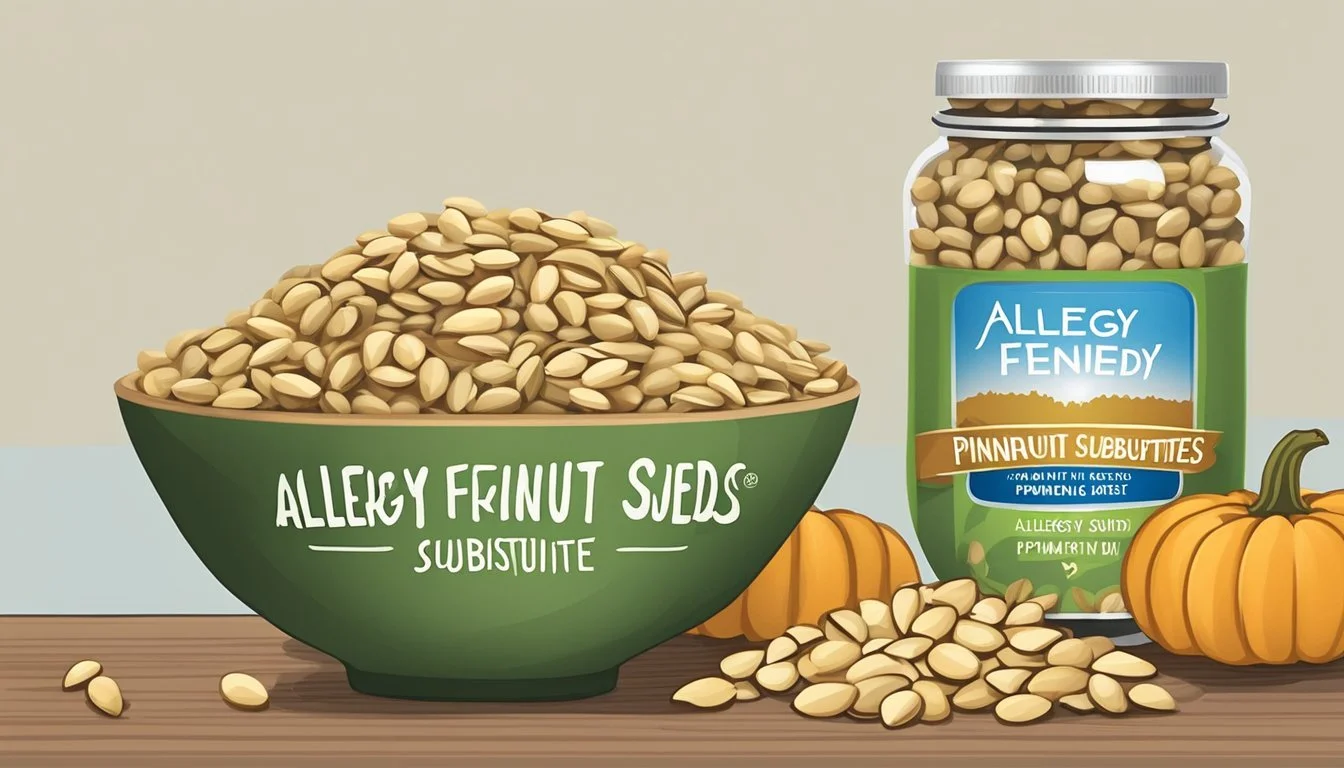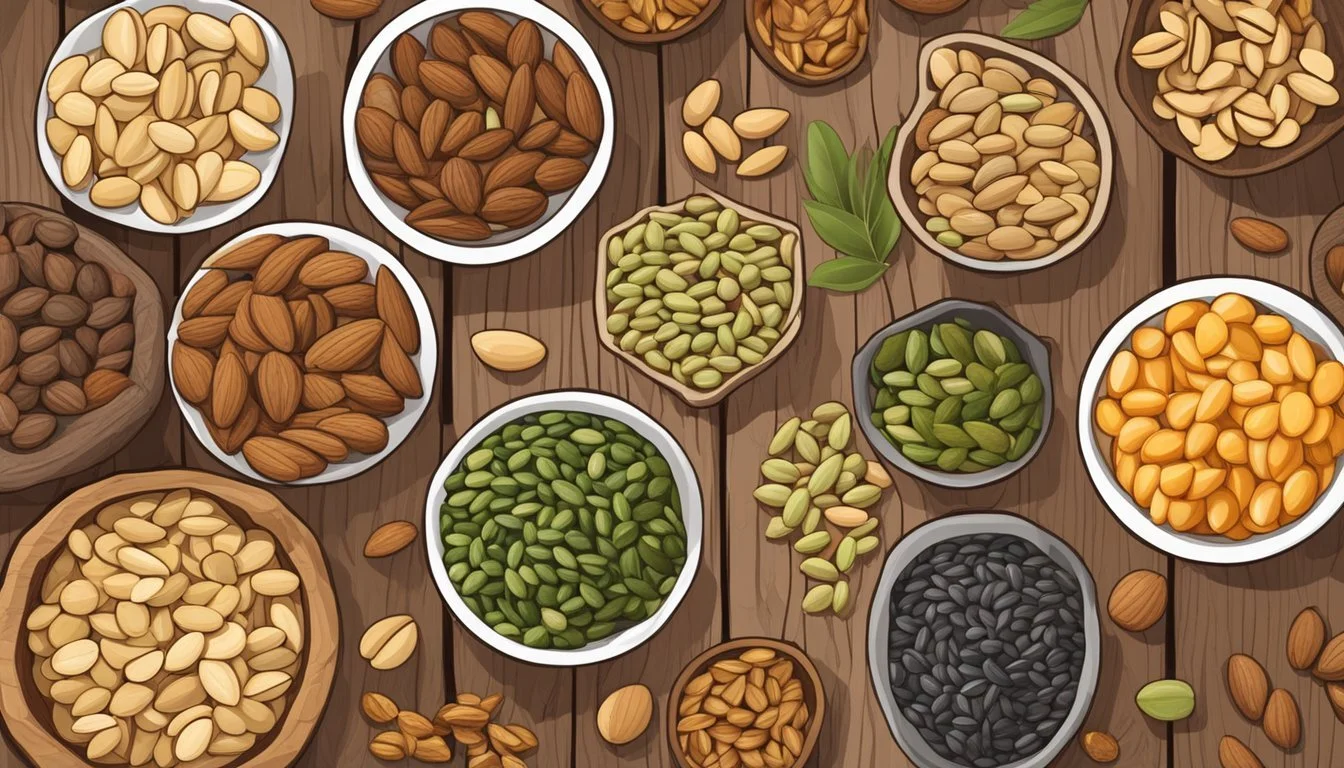Pinenut Substitutes
Top Alternatives for Your Recipes
Pine nuts, with their buttery texture and mild, sweet flavor, are a cherished ingredient in various cuisines, notably Italian, where they are a staple in pesto. They also add a distinct touch to salads, pastries, and meat dishes. However, due to their price and occasional scarcity, cooks and consumers often seek alternatives that deliver a similar texture and flavor profile to dishes ordinarily graced by pine nuts.
A variety of seeds and nuts can stand in for pine nuts, ensuring that dishes retain the desired culinary qualities without compromise. Cashews are frequently noted for their similar color and creaminess, making them an excellent direct substitute particularly in pesto and other sauces. Hazelnuts, another commendable alternative, can offer a comparable nuttiness to sweet and savory recipes alike.
With an array of substitutes available, ranging from the familiar roasted peanut to the luxurious macadamia nut, there is no shortage of options for those looking to replicate or even enhance the pine nut's unique contribution to their cooking. Each alternative brings its own character to dishes, allowing for culinary experimentation and sometimes even cost savings without sacrificing the essence of the original recipe.
Understanding Pine Nuts
Pine nuts, the edible seeds of pine trees, are valued for their distinctive nutty flavor and rich texture. They are a staple in many cuisines, notably Italian and Mediterranean, and contribute to the nutritional value as well as the taste of dishes.
Nutritional Profile
Pine nuts are a dense source of energy, primarily from fats, including monounsaturated fats which can be beneficial for heart health. They also provide protein, essential vitamins, and minerals. The seeds are especially rich in vitamin E, known for its antioxidant properties. Here's a quick glance at the nutritional composition of pine nuts:
Protein: Essential for muscle repair and growth.
Vitamins: High in vitamin E, important for skin health and immune function.
Minerals: Contains minerals like magnesium and zinc.
Antioxidants: Help combat oxidative stress in the body.
Common Uses in Cuisine
Pine nuts feature prominently in Italian and Mediterranean recipes due to their unique flavor profile. They can be found in:
Pesto: A classic Italian sauce where their nutty flavor complements basil, parmesan, and olive oil.
Salads: For a textural contrast and a punch of flavor.
Baked goods: Often used for their texture and flavor in cookies and cakes.
Meat and fish dishes: As a coating or garnish, enhancing the overall dish with a crunch.
They are toasted to intensify their nutty flavor, which is mild yet distinct, making them a sought-after ingredient for chefs and home cooks alike.
Identifying Suitable Substitutes
Finding the right substitute for pine nuts involves considering both the desired texture and flavor profile to ensure culinary success.
Criteria for Substitution
The criteria for choosing an appropriate substitute for pine nuts hinge on two aspects: the substitute's ability to mimic the unique flavor and texture of pine nuts, and how well it complements the other ingredients in the recipe. Substitutes may come in various forms, such as whole nuts, chopped, ground, or as a nut-free option. One should consider whether raw or roasted substitutes better serve the dish, as roasting can enhance the nutty flavor and add depth.
Impact of Texture and Flavor
Texture plays a pivotal role in substitution, as pine nuts offer a distinct creaminess that enriches dishes such as pesto. Candidates for substitution should ideally possess a similar size and provide a creamy or buttery texture to merge seamlessly with the dish's other components.
A substitute's flavor should be neutral to nutty, without overpowering the dish. A strong flavor like that of hazelnuts could be desired in sweet dishes, while a more subtle flavor like that of cashews might be better for savory dishes. A table summarizing the substitutes that best replicate pine nuts in terms of both earthy flavor and creamy texture might look like this:
Substitute Texture Flavor Best Used In Cashews Creamy, similar to pine nuts Mild, nutty Pesto, sauces Pecans Buttery, slightly crumbly Sweet, buttery Baked goods, salads Hazelnuts Crunchy Earthy, nutty Desserts, toppings Peanuts Varied, depending on preparation Earthy, unique Cookies, savory dishes White Beans Creamy, soft Neutral Pesto, nut-free options
These substitutes should be carefully chosen based on how their texture and flavor will impact the finished dish, particularly if they are a central ingredient.
Nut-Based Substitutes
In seeking alternatives to pine nuts, one should consider the array of nut-based substitutes that offer a range of flavors and textures. These alternatives can provide a similar nutty essence and richness to dishes where pine nuts are traditionally used.
Cashews
Cashews present a creamy texture and a subtly sweet taste, making them a versatile substitute for pine nuts. Often more affordable, they're a popular choice in pesto and other recipes requiring a soft, oily nut.
Almonds
Almonds have a slightly firmer texture and are a healthful option, rich in nutrients. Blanched and slivered almonds can mimic the pine nut's texture, ideal for salads and pasta dishes.
Walnuts
Walnuts bring an earthy flavor that complements baked goods and stuffings. Their robust texture provides a substantial bite, suitable for recipes where a more pronounced nut experience is desired.
Pecans
Pecans offer a buttery and rich profile. When chopped, they can double as a pine nut substitute in savory dishes and are particularly delightful in sweet desserts.
Pistachios
Pistachios are known for their vibrant green hue and can add a pop of color as well as a distinct, slightly sweet flavor to dishes, emulating the pine nut's aesthetic and taste qualities.
Hazelnuts
Hazelnuts impart a pronounced nutty flavor that works well in baked goods and spreads. Their characteristic taste can stand in for pine nuts when roasted and crushed.
Brazil Nuts
Brazil nuts may be larger, but when chopped, they can serve as an effective substitute, bringing a similar richness to dishes that call for pine nuts.
Macadamia Nuts
Macadamia nuts, one of the tastiest nuts, carry a creamy, buttery texture that can elegantly replace pine nuts in desserts and savory applications alike.
Seed-Based Substitutes
For those seeking alternatives to pine nuts, a variety of seed-based substitutes offer nut-free options that can mimic the texture and enhance the flavor of various dishes. These substitutes are often more affordable and readily available.
Sunflower Seeds
Sunflower seeds are a versatile and nut-free alternative that can replace pine nuts in many recipes. They provide a mild, nutty flavor and a firm, satisfying crunch. Toasted sunflower seeds enhance their flavor and make them a closer match to pine nuts.
Flavor: Mild, slightly sweet
Best in: Pesto, salads, baked goods
Pumpkin Seeds
Pumpkin seeds, also known as pepitas, are another excellent substitute for pine nuts. When toasted, their rich, earthy flavor comes to the forefront, resembling the distinct taste pine nuts are known for.
Flavor: Rich, earthy
Use when toasted: To enhance flavor and texture
Ideal for: Pesto, garnishes, nut mixes
Sesame Seeds
Sesame seeds, with their delicate size and slightly bitter taste, can be used as a pine nut substitute. They're most effective when slightly toasted, which helps to decrease the bitterness and brings out a nuttier flavor.
Flavor Profile:
Before toasting: Mild with a slight bitterness
After toasting: Enhanced nuttiness
Application: Sprinkled over salads and included in breads or cookies
Hemp Seeds
Hemp seeds offer a nutty taste with a creamy texture that can stand in for pine nuts, particularly in smoothies and salad dressings. These seeds are a great nut-free option, albeit with a softer consistency than pine nuts.
Comparable Attributes:
Flavor: Softly nutty and earthy
Consistency: Creamier than pine nuts
Ideal Usage: Nutrient-rich addition to smoothies, yogurts, and baked goods
Unique Non-Nut Alternatives
For those with nut allergies or seeking special nut-free options, finding a substitute for pine nuts in recipes can be a challenge. The following unique alternatives offer a versatile and healthy option for those in need.
Edamame and Green Soybeans
Edamame beans, or green soybeans, present a great alternative to pine nuts. These young soybeans are harvested before they harden and offer a creamy texture with a hint of sweetness that can mimic the mouthfeel of pine nuts. Not only are edamame beans a fantastic nut-free option, but they also provide a wealth of nutrients, including protein and fiber, making them a healthy choice for various dishes.
Nutrition: High in protein and fiber
Texture: Creamy and slightly sweet
Use: Can be pureed for spreads or used whole in salads and other dishes
White Beans
White beans are another exceptional pine nut substitute for those seeking a nut-free ingredient. They have a soft texture and a neutral flavor that absorbs the tastes of other ingredients well. When mashed or pureed, white beans can act as a thickener in dips or spreads, offering a similar consistency to that of ground pine nuts without the risk for individuals with nut allergies.
Nutrition: Rich source of vitamins and minerals
Texture: Soft and versatile for blending
Use: Ideal for thickening pestos, dips, and as a base in spreads
Allergy-Friendly Substitutes
For individuals with nut allergies, finding suitable substitutes for pine nuts in recipes is essential. This section explores allergy-friendly alternatives that offer similar textures and flavors without the allergens.
Understanding Nut Allergies
Nut allergies are among the most common food allergens and can cause severe reactions. Individuals with nut allergies need to avoid all tree nuts and peanuts, as they may trigger an immune response. Hence, it is crucial to identify nut-free options that can mimic the characteristics of pine nuts, enabling those with allergies to enjoy various dishes without concern.
Nut-Free Substitute for Pine Nuts:
Sunflower Seeds: These seeds provide a nutty flavor and a crunchy texture, making them a suitable pine nut substitute in various recipes.
Pepitas (Pumpkin Seeds): A green, crunchy seed that serves as an excellent nut-free option in recipes requiring a similar texture to nuts.
An alternative that is often recommended for both flavor and texture is:
Hemp Seeds: While small, these seeds are rich in nutrients and have a pleasant, subtle taste that pairs well with many recipes traditionally calling for pine nuts.
To ensure these substitutes provide the best possible result in cooking:
Toast the seeds lightly to enhance their flavors and bring them closer to the profile of pine nuts.
Measure the seeds in correspondence to pine nuts using appropriate substitution ratios recommended for each recipe.
Individuals with allergies can readily use these allergy-friendly alternatives, ensuring they can enjoy their meals safely and with similar culinary attributes to those that pine nuts would provide.
Creative Uses of Substitutes in Recipes
When pine nuts are unavailable or too pricey, various substitutes can seamlessly fit into recipes, maintaining or even enhancing the flavors and textures that make dishes delightful.
Substitutes in Pesto
In pesto, cashews are a popular choice due to their creamy texture and rich taste. They blend well with basil and parmesan, emulating the traditional pesto made with pine nuts. A ratio of 3:2, where 1.5 tablespoons of cashews replace 1 tablespoon of pine nuts, works well.
Substitutes in Salads
For salads, chopped hazelnuts or peanuts add a satisfying crunch and nutty depth. Hazelnuts work particularly well in salads that feature a mix of leafy greens and robust flavors like blue cheese, while peanuts can serve as a cost-effective and flavorful salad topping, especially in Asian-style salads.
Substitutes in Baked Goods
In baked goods, almonds or walnuts can replace pine nuts to impart a toasty flavor and crunchiness. Almonds are ideal for cookies and cakes, and their slivers can be sprinkled on top for a decorative finish. Walnuts, despite a slightly more bitter taste due to their skin, can offer a bold twist in brownies and other desserts.
Substitutes in Hot Dishes
Hot dishes, such as pasta and stir-fries, can benefit from the substitution of pecans or Brazil nuts. These nuts should be chopped to be about the same size as pine nuts for a consistent mouthfeel. Pecans, known for their slightly sweet yet creamy consistency, enhance pasta dishes, while Brazil nuts, with their meaty texture, are excellent in stir-fries and savory recipes, providing a similar buttery flavor to pine nuts.
Tips for Selecting and Preparing Substitutes
When substituting pine nuts in a recipe, both the selection of an appropriate alternative and the preparation method are critical to maintain the desired taste and texture of the dish. The choice of substitute and preparation technique can significantly influence the flavor profile and mouthfeel of the final product.
Toasting for Enhanced Flavor
Toasting nuts can dramatically change their flavor and texture, making them a more suitable stand-in for pine nuts. Here is how one should toast different substitutes:
Hazelnuts: Roast in a dry pan for 4-5 minutes until the nuts are golden and the skin begins to crack. The resulting earthy flavor with a hint of sweetness is perfect for baked goods and salads.
Almonds: Bake at 350°F for 10-12 minutes. This process gives almonds a richer flavor that complements both savory and sweet dishes, like pesto or cookies.
Toasting is especially important when a recipe calls for raw pine nuts, as it brings out a comparable flavor in the substitutes.
Choosing the Right Substitute for Your Dish
Selecting the right nut to replace pine nuts depends on the dish's requirements for flavor and texture. Consider the following when choosing a substitute:
For a creamy texture: Substitute with cashews or white beans, particularly in sauces, pestos, and dips. Cashews should be used unsalted and can be toasted or raw. White beans can be blended to achieve a similar creaminess to pine nuts.
For a strong and buttery flavor: Opt for Brazil nuts. Their large size and meaty texture make them a good choice for recipes where pine nuts are a prominent feature.
It's important to use the substitute in the same ratio as pine nuts to maintain balance in the recipe — most substitutes work well in a 1:1 ratio. Additionally, while choosing the substitute, one must take into account any potential food allergies and the intended flavor profile of the dish.
Economic Considerations and Availability
The price and accessibility of pine nuts can vary significantly compared to other nuts and seeds. They tend to be one of the more expensive options on the market, and their availability may be limited in some areas due to import constraints or regional scarcity.
Cost Comparison
Pine Nuts: Often regarded as a premium product, they can be expensive due to factors such as labor-intensive harvesting and limited cultivation regions.
Substitute Relative Cost Availability Nut-Free Almonds More affordable Widely available No Walnuts More affordable Widely available No Sunflower Seeds Less expensive Widely available Yes Pumpkin Seeds Less expensive Widely available Yes Pecans More affordable Generally available No Cashews More affordable Widely available No White Beans Least expensive Widely available Yes
Each substitute has its relative cost and availability. The nut-free options like sunflower seeds, pumpkin seeds, and white beans provide affordable and accessible alternatives to pine nuts. They are especially suitable for individuals with nut allergies.
Conclusion
In the landscape of culinary substitutes, a range of alternatives exist for pine nuts. Chefs and home cooks can confidently rely on various nuts to mimic the texture and flavor profile of pine nuts in their dishes. Walnuts stand out as an economical choice, offering a comparable crunch with their signature, slightly bitter taste when their skin is included. They are especially effective when roasted, enhancing dishes like pesto, salads, and cookies.
Cashews and pecans offer a creamier consistence, with cashews being preferred for their similar flavor to pine nuts and their ideal substitution ratio (3 cashews to 2 pine nuts). Meanwhile, pecans’ inherent sweetness pairs well with both sweet and savory creations. Hazelnuts bring an earthy tone that complements brownies, salads, and vegetable dishes.
For those seeking a more budget-friendly option, peanuts emerge as an economical and versatile substitute across a variety of recipes. It is advisable to toast substitutes like cashews to enrich their flavor and closely replicate the pine nuts’ essence in cooking.
When substituting, one must take into account the distinct taste profile and texture of the chosen alternative, adjusting the quantity to achieve the desired result in the final dish. By doing so, cooks maintain the integrity and appeal of their culinary creations even when pine nuts are unavailable.








